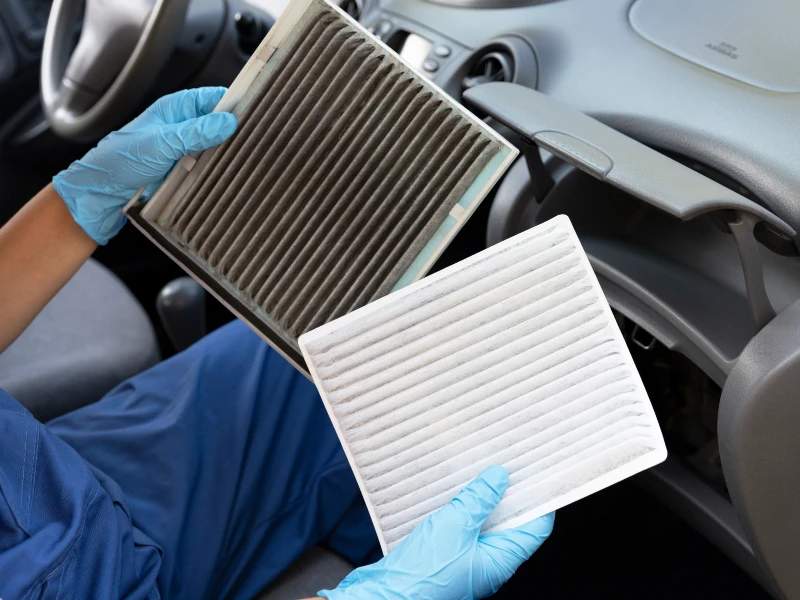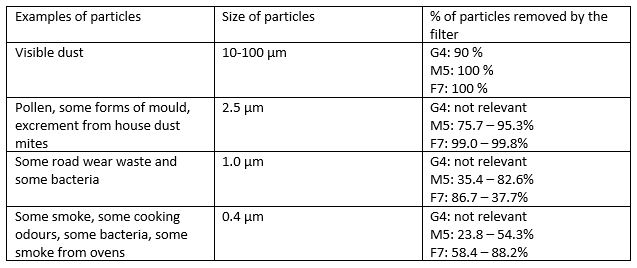Ventilation filter guide
A ventilation system keeps the air in your home clean by filtering air particles. Find out which filter suits your needs the best.
Do you live next to a road with heavy traffic? Or in a residential area with a lot of wood stoves? Are you allergic to pollen? Dampness or mould? Most of us have different, minor health issues, and therefore, there are different kinds of filters for filtering different kinds of air particles that pass into your home through your Genvex ventilation system.
A Genvex system exchanges all air in your home every 2 hours, replaces the unhealthy indoor air with clean, fresh air, and filters out a large amount of unhealthy and allergenic particles. If you are thinking about getting a ventilation system, or you already have one, this will give you some idea of what the different filters actually do and the impact they have on your indoor climate and health, so that you choose the right product for your needs.

Two kinds of ventilation filters
There are cleaning filters to clean the air in both the intake and exhaust ducts of the ventilation system.
The fresh air you breathe indoors is outdoor air that is cleansed of particles. When the used air is sucked out again, it should also be free of dust and other particles – this gives your system longer life and helps you get the most out of it.
Why should you remove particles from outdoors air?
Our homes are full of particles, some of which can potentially make us ill. Some particles come from outdoors through open windows and unsealed cracks in the house, such as pollen, mould, smoke from wood stoves, exhaust emissions and asphalt particles. Other particles might be created by you, such as particles from cooking, candles and electronic devices.
Some of these microscopic air particles may increase the risk of cardiovascular diseases and respiratory disorders.
(Source: Center for Indeklima og Sundhed i Boliger og Sundhedsstyrelsen] (Centre for Indoor air and Health in dwellings)
The ventilation system exchanges air – the filter cleans it
Unlike air that is exchanged the traditional way through open windows, a ventilation system has the advantage of being able to filter out particles of a certain size before allowing the air into the house. Also, all the air in the house is exchanged every 2 hours. This means, among other things, that particles from indoor sources are removed from your house and you can avoid damp, increased CO2 intake and other things that can make your indoor environment an unhealthy place.
Please read the article Stearinlys og stegeos spreder skadelige partikler i dit hjem (”Candles and smoke from frying pans spread harmful particles in your home”)
What kinds of ventilation filters are there, and which one should you choose?
The three standard types of filters are:
G4 – coarse filter
M5 – medium filter
F7 – fine filter
The finer the filter, the more and smaller particles it will filter from the air. However, a finer filter means that the ventilation system has to work harder to transport air through the system.
That means you should not choose a finer filter than you need.
Exhaust air does not need more than a G4 filter, since the air indoors has already been cleaned once, which is enough to keep the ventilation system’s inner workings clean.
You should choose either a G4, M5 or F7 for intake air. So, what is the difference between the 3?
G4 only removes dust particles that are big enough to be seen with the naked eye. A finer filter that also filters out smaller particles would probably be a better choice for most households. For example, pollen, asphalt particles and smoke from wood stoves that you would rather not let into the house.
M5 suits most people’s needs, but if you need to filter the air even more, perhaps due to allergies, you can choose an F7 filter instead. You can also particularly order even finer filters.
Size of particles removed by filters
(Source: Filtertek og Statens Byggeforskningsinstitut) (Danish Building Research Institute)
Are you allergic?
People who suffer from allergies can benefit a lot from a ventilation system. The most common kinds of pollen particles are around 20-80µm, but some pollen particles, for example from forget-me-nots, can be as small as 2.5µm.
If you choose an F7 filter for the intake, 99% of particles larger than 2.5µm will be removed.
Particle size of other allergens

Fungus particles are around 2-20µm. (Source: Center for Indeklima og Sundhed i Boliger og Astma-Allergi Danmark) (Centre for Indoor air and Health in dwellings)
House dust mite waste particles are around 10-40µm. (Source: Astma-Allergi Danmark)
Bacteria are around 0.2-2µm. (Source: denstoredanske.dk)
Remember to change the filter
Genvex recommends that you change the filter at least once every six months. If the filters get blocked, it takes a lot of energy to force the air through, and some particles might be forced through.
You can connect a filter alarm to the controls to remind you when to change it. To keep everything working optimally, you can also enter into a service agreement to have the system cleaned and the filter changed every six months.
Need a new filter? Buy it in our webshop.